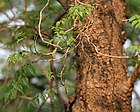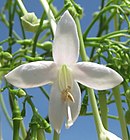Note: This is a project under development. The articles on this wiki are just being initiated and broadly incomplete. You can Help creating new pages.
Millingtonia hortensis
Millingtonia hortensis, the tree jasmine or Indian cork tree, is the sole species in the genus Millingtonia, is a tree native to South Asia & South East Asia. In the name Millingtonia hortensis, Millingtonia is named for Sir Thomas Millington who was an inspiration to Carl Linnaeus the Younger who first described the genus. The specific epithet 'hortensia' derives from 'hortensis' and 'hortus' which in Latin is related to garden. In its synonym, Bignonia suberosa, 'suberosa' derives from 'suberos' which means 'corky' in Latin.
Contents
- 1 Uses
- 2 Parts Used
- 3 Chemical Composition
- 4 Common names
- 5 Properties
- 6 Habit
- 7 Identification
- 8 List of Ayurvedic medicine in which the herb is used
- 9 Where to get the saplings
- 10 Mode of Propagation
- 11 How to plant/cultivate
- 12 Commonly seen growing in areas
- 13 Photo Gallery
- 14 References
- 15 External Links
Uses
antipyretic, sinusitis, cholagogue, tonic in folklore, treatment of asthma, carminative.
Parts Used
Chemical Composition
hortensis flower is shown in Fig. 1. The most abundant compounds found were solanesol (25.72%), trans-farnesol (19.71%), nerolidol (8.54%), palmetic acid (6.77%), vanillin (6.20%), oleic acid (4.54%), linoleic acid (3.87%), L-linalool (3.37%), 1-octen-3-ol (1.67%), α-farnesene (1.22%), and methyl salicylate (1.03%). [1]
Common names
| Language | Common name |
|---|---|
| Kannada | Beratu, ಬಿರಾತೆ ಮರಾ Birate mara |
| Hindi | नीम चमेली Neem Chameli |
| Malayalam | കടെസമ് Katesam |
| Tamil | கட் மல்லீ Kat-malli |
| Telugu | కవుకీ Kavuki |
| Marathi | NA |
| Gujarathi | NA |
| Punjabi | NA |
| Kashmiri | NA |
| Sanskrit | |
| English | Indian Cork Tree, Tree Jasmine |
Properties
Reference: Dravya - Substance, Rasa - Taste, Guna - Qualities, Veerya - Potency, Vipaka - Post-digesion effect, Karma - Pharmacological activity, Prabhava - Therepeutics.
Dravya
Rasa
Guna
Veerya
Vipaka
Karma
Prabhava
Habit
Identification
Leaf
| Kind | Shape | Feature |
|---|---|---|
| Simple | slightly round-toothed | Each is from 2.5 to 7.5 cm. long. Sometimes the lower pinnae, are again divided and bear one pair of three leaved pinnae, one or two pairs of leaflets and one leaflet at the end. |
Flower
| Type | Size | Color and composition | Stamen | More information |
|---|---|---|---|---|
| Unisexual | tiny bell-shaped calyx, a long slender tube of palest green dividing into four waxy | silver white in colour | Many flowers are delicately tinted with rose. As the flowers are short-lived, the flower sprays mostly consist largely of long whitish buds |
Other features
List of Ayurvedic medicine in which the herb is used
Where to get the saplings
Mode of Propagation
How to plant/cultivate
Millingtonia hortensis Linn. is cultivated in most parts of India, both in gardens and avenues. Tall and straight, with comparatively few branches, its popularity lies in its ornamental value. It is a fine tree, fast growing, but with brittle wood, liable to be damaged by storms. [3]
Commonly seen growing in areas
Photo Gallery
References
External Links
- Ayurvedic Herbs known to be helpful to treat antipyretic
- Ayurvedic Herbs known to be helpful to treat sinusitis
- Ayurvedic Herbs known to be helpful to treat cholagogue
- Ayurvedic Herbs known to be helpful to treat tonic in folklore
- Ayurvedic Herbs known to be helpful to treat treatment of asthma
- Ayurvedic Herbs known to be helpful to treat carminative
- Herbs with Leaves used in medicine
- Herbs with Flowers used in medicine
- Herbs with common name in Kannada
- Herbs with common name in Hindi
- Herbs with common name in Malayalam
- Herbs with common name in Tamil
- Herbs with common name in Telugu
- Herbs with common name in English
- Habit - Tree
- Index of Plants which can be propagated by Seeds
- Herbs that are commonly seen in the region of Garden area
- Herbs
- Bignoniaceae




